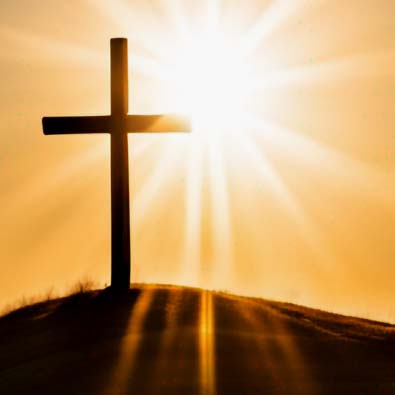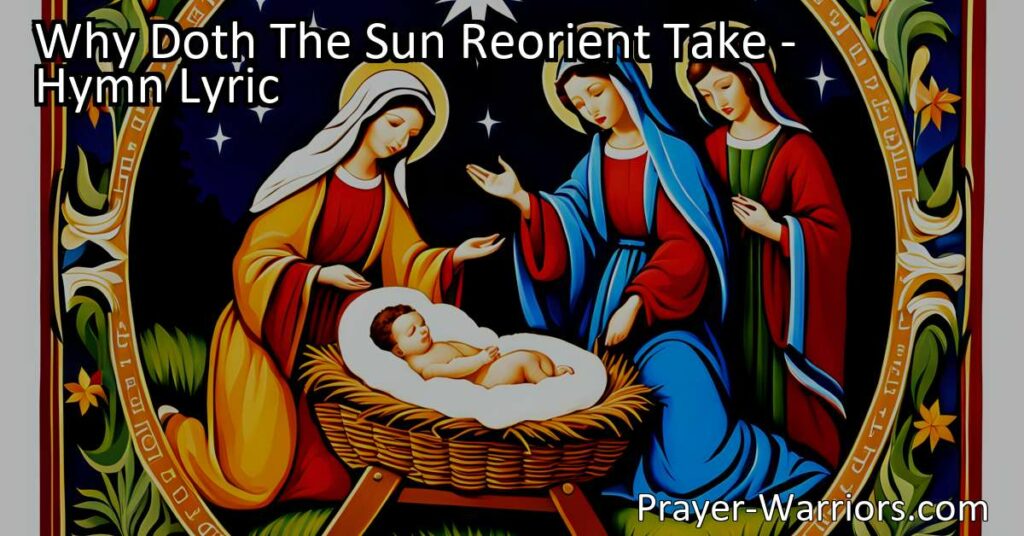Why Doth The Sun Reorient Take – Hymn Lyric
Why Doth The Sun Reorient Take: The Symbolism of Christ’s Birth and the Renewal of the World The hymn “Why Doth The Sun Reorient Take” explores the profound significance of Christ’s birth and the impact it has on the world. It portrays Jesus as the light of the world, bringing renewal, hope, and salvation. The hymn celebrates His birth and the transformation it brings to both heaven and earth, encouraging us to embrace His teachings and prepare for His return.
Table of Contents
Why Doth The Sun Reorient Take – Hymn Lyric
Why doth the sun re-orient take A wider range, his limits break? Lo! Christ is born, and o’er earth’s night Shineth from more to more the light! Too swiftly did the radiant day Her brief course run and pass away: She scarce her kindly torch had fired Ere slowly fading it expired.
Now let the sky more brightly beam, The earth take up the joyous theme: The orb a broadening pathway gains And with its erstwhile splendour reigns.
Sweet babe, of chastity the flower, A virgin’s blest mysterious dower! Rise in Thy twofold nature’s might: Rise, God and man to reunite!
Though by the Father’s will above Thou wert begot, the Son of Love, Yet in His bosom Thou didst dwell, Of Wisdom the eternal Well; Wisdom, whereby the heavens were made And light’s foundations first were laid: Creative Word! all flows from Thee! The Word is God eternally.
For though with process of the suns The ordered whole harmonious runs, Still the Artificer Divine Leaves not the Father’s inmost shrine.
The rolling wheels of Time had passed O’er their millennial journey vast, Before in judgment clad He came Unto the world long steeped in shame.
The purblind souls of mortals crass Had trusted gods of stone and brass, To things of nought their worship paid And senseless blocks of wood obeyed.
And thus employed, they fell below The sway of man’s perfidious foe: Plunged in the smoky sheer abyss They sank bereft of their true bliss.
But that sore plight of ruined man Christ’s pity could not lightly scan: Nor let God’s building nobly wrought Ingloriously be brought to nought.
He wrapped Him in our fleshly guise, That from the tomb He might arise, And man released from death’s grim snare Home to His Father’s bosom bear.
This is the day of Thy dear birth, The bridal of the heaven and earth, When the Creator breathed on Thee The breath of pure humanity.
Ah! glorious Maid, dost thou not guess What guerdon thy chaste soul shall bless, How by thy ripening pangs is bought An honour greater than all thought?
O what a load of joy untold Thy womb inviolate doth hold! Of thee a golden age is born, The brightness of the earth’s new morn!
Hearken! doth not the infant’s wail The universal springtide hail? For now the world re-born lays by Its gloomy, frost-bound apathy.
Methinks in all her rustic bowers The earth is spread with clustering flowers: Odours of nard and nectar sweet E’en o’er the sands of Syrtes fleet.
All places rough and deserts wild Have felt from far Thy coming, Child: Rocks to Thy gentle empire bow And verdure clothes the mountain brow.
Sweet honey from the boulder leaps: The sere and leafless oak-bough weeps A strange rich attar: tamarisks too Of balsam pure distil the dew.
Blessed for ever, cradle dear, The lowly stall, the cavern drear! Men to this shrine, Eternal King, With dumb brutes adoration bring.
The ox and ass in homage low Obedient to their Maker bow: Bows too the unlearn’d heartless crowd Whose minds the sensual feast doth cloud.
Though, by the faithful Spirit impelled, Shepherds and brutes, unreasoning held, Yea, folk that did in darkness dwell Discern their God in His poor cell:
Yet children of the sacred race Blindly abhor the Incarnate grace: By philtres you might deem them lulled Or by some bacchic phrenzy dulled.
Why headlong thus to ruin stride? If aught of soundness in you bide, Behold in Him the Lord divine Of all your patriarchal line.
Mark you the dim-lit cave, the Maid, The humble nurse, the cradle laid, The helpless infancy forlorn: Yet thus the Gentiles’ King was born!
Ah sinner, thou shalt one day see This Child in dreadful majesty, See Him in glorious clouds descend, While thou thy guilty heart shalt rend.
Vain all thy tears, when loud shall sound The trump, when flames shall scorch the ground, When from its hinge the cloven world Is loosed, in horrid tumult hurled.
Then throned on high, the Judge of all Shall mortals to their reckoning call: To these shall grant the prize of light, To those Gehenna’s gloomy night.
Then, Israel, shalt thou learn at length The Cross hath, as the lightning, strength: Doomed by thy wrath, He now is Lord, Whom Death once grasped but soon restored.
Meaning of Why Doth The Sun Reorient Take
Why Doth The Sun Reorient Take: The Symbolism of Christ’s Birth and the Renewal of the World
In the hymn titled “Why Doth The Sun Reorient Take,” the author explores the profound significance of Christ’s birth and its impact on the world. The hymn beautifully portrays the idea that Jesus, as the light of the world, brings renewal, hope, and salvation. This hymn celebrates the birth of Christ and the transformation it brings to both heaven and earth.
The hymn begins by questioning why the sun changes its course, breaking through its usual limits. The answer lies in the birth of Christ, which brings forth an even brighter light that shines upon the earth. The sun is used as a metaphor for the spiritual light that Christ brings into the world, illuminating the darkness of sin and ignorance.
The author exclaims that the radiant day, symbolizing the light of Christ, passes too quickly. The brief duration of the day represents the limited time that Jesus spent on Earth, spreading His message of love, forgiveness, and redemption. However, even though His physical presence was short-lived, the impact of His teachings and sacrifice continues to resonate throughout history.
The hymn goes on to describe the dual nature of Jesus as both God and man. It acknowledges that while Jesus was begotten by the Father’s will and existed as the Son of Love, He also dwelled in the wisdom of God. This wisdom is portrayed as the creative force behind the heavens and the foundation of light.
The hymn emphasizes the importance of Christ’s incarnation by exploring the state of the world before His coming. It paints a picture of humanity trapped in idolatry, worshiping gods made of stone and brass. These false idols led people astray, causing them to lose sight of their true purpose and happiness.
The hymn expresses Christ’s compassion for the plight of mankind, unwilling to let God’s creation be lost to sin and ignorance. He chooses to take on human flesh, being born as a baby, to ultimately triumph over death and bring humanity back to the embrace of the Father.
The birth of Jesus is hailed as the bridal union between heaven and earth. It symbolizes the divine union of the spiritual and physical realms, with Christ being the bridge between the two. His birth is seen as a breath of pure humanity, breathed upon Him by the Creator Himself.
The hymn further praises the Virgin Mary, referring to her as a glorious maid. It highlights the honor she holds for being the mother of the Savior, as well as the pain and sacrifice she endures through her childbirth. Her womb is compared to a golden age, bringing forth the brightness of a new dawn upon the earth.
The hymn paints a vibrant picture of the world rejoicing in the birth of Christ. It suggests that the earth itself is adorned with flowers and filled with sweet fragrances to celebrate the coming of the Savior. The wonders of nature are said to bow to Christ’s gentle empire, with even rocks and mountains expressing their reverence.
The hymn acknowledges that while the shepherds and unlearned individuals recognized the divine presence in the humble manger, some of the chosen people, blinded by their own prejudices, reject and abhor the Incarnate grace of Christ. It warns of the consequences of such rejection, leading to ruin and eternal separation from God.
The hymn concludes with a reminder of the coming judgment, where Christ, now gloriously enthroned as the Judge of all, will call humanity to account for their actions. It emphasizes the importance of recognizing the power of the Cross and the destiny of eternal life or damnation that awaits every individual.
In conclusion, “Why Doth The Sun Reorient Take” is a powerful hymn that beautifully captures the transformative nature of Christ’s birth. It portrays His arrival as the renewal of both heaven and earth, bringing forth light in the midst of darkness and hope in the face of despair. The hymn serves as a reminder of the immense significance and lasting impact of Christ’s birth, urging us to embrace His teachings, seek redemption, and prepare for His second coming.
I hope this hymn inspired image brings you hope and peace. Share it with someone who needs it today!


